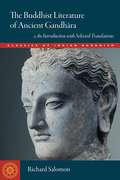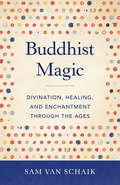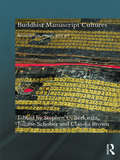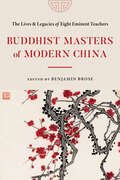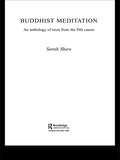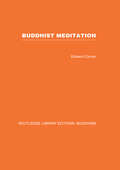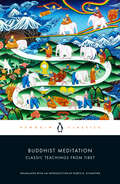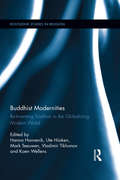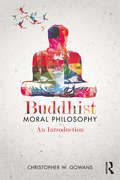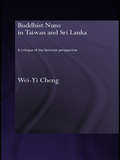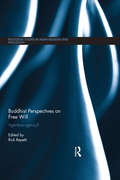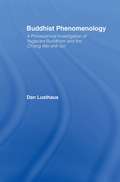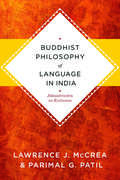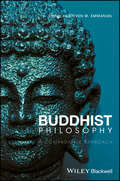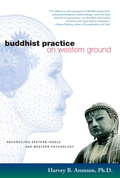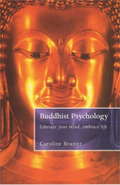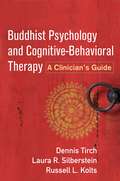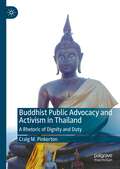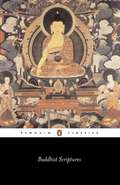- Table View
- List View
Buddhist Literature of Ancient Gandhara: An Introduction with Selected Translations
by Salomon RichardDiscover the fascinating history of a long-hidden Buddhist culture at a historic crossroads.In the years following Alexander the Great’s conquest of the East, a series of empires rose up along the Silk Road. In what is now northern Pakistan, the civilizations in the region called Gandhara became increasingly important centers for the development of Buddhism, reaching their apex under King Kaniska of the Kusanas in the second century CE. Gandhara has long been known for its Greek-Indian synthesis in architecture and statuary, but until about twenty years ago, almost nothing was known about its literature. The insights provided by manuscripts unearthed over the last few decades show that Gandhara was indeed a vital link in the early development of Buddhism, instrumental in both the transmission of Buddhism to China and the rise of the Mahayana tradition. The Buddhist Literature of Ancient Gandhara surveys what we know about Gandhara and its Buddhism, and it also provides translations of a dozen different short texts, from similes and stories to treatises on time and reality.
Buddhist Magic: Divination, Healing, and Enchantment through the Ages
by Sam van SchaikA fascinating exploration of the role that magic has played in the history of BuddhismAs far back as we can see in the historical record, Buddhist monks and nuns have offered services including healing, divination, rain making, aggressive magic, and love magic to local clients. Studying this history, scholar Sam van Schaik concludes that magic and healing have played a key role in Buddhism's flourishing, yet they have rarely been studied in academic circles or by Western practitioners. The exclusion of magical practices and powers from most discussions of Buddhism in the modern era can be seen as part of the appropriation of Buddhism by Westerners, as well as an effect of modernization movements within Asian Buddhism. However, if we are to understand the way Buddhism has worked in the past, the way it still works now in many societies, and the way it can work in the future, we need to examine these overlooked aspects of Buddhist practice.In Buddhist Magic, van Schaik takes a book of spells and rituals--one of the earliest that has survived--from the Silk Road site of Dunhuang as the key reference point for discussing Buddhist magic in Tibet and beyond. After situating Buddhist magic within a cross-cultural history of world magic, he discusses sources of magic in Buddhist scripture, early Buddhist rituals of protection, medicine and the spread of Buddhism, and magic users. Including material from across the vast array of Buddhist traditions, van Schaik offers readers a fascinating, nuanced view of a topic that has too long been ignored.
Buddhist Manuscript Cultures: Knowledge, Ritual, and Art (Routledge Critical Studies in Buddhism)
by Stephen C. Berkwitz Juliane Schober Claudia BrownBuddhist Manuscript Cultures explores how religious and cultural practices in premodern Asia were shaped by literary and artistic traditions as well as by Buddhist material culture. This study of Buddhist texts focuses on the significance of their material forms rather than their doctrinal contents, and examines how and why they were made. Collectively, the book offers cross-cultural and comparative insights into the transmission of Buddhist knowledge and the use of texts and images as ritual objects in the artistic and aesthetic traditions of Buddhist cultures. Drawing on case studies from India, Gandhara, Sri Lanka, Thailand, Mongolia, China and Nepal, the chapters included investigate the range of interests and values associated with producing and using written texts, and the roles manuscripts and images play in the transmission of Buddhist texts and in fostering devotion among Buddhist communities. Contributions are by reputed scholars in Buddhist Studies and represent diverse disciplinary approaches from religious studies, art history, anthropology, and history. This book will be of interest to scholars and students working in these fields.
Buddhist Masculinities
by Ward Keeler Stephen C. Berkwitz Marcus Evans Amy Paris Langenberg Geng Song Rebecca Mendelson Bee Scherer Joshua Brallier Shelton Dessislava Vendova Natawan WongchalardWhile early Buddhists hailed their religion’s founder for opening a path to enlightenment, they also exalted him as the paragon of masculinity. According to Buddhist scriptures, the Buddha’s body boasts thirty-two physical features, including lionlike jaws, thighs like a royal stag, broad shoulders, and a deep, resonant voice, that distinguish him from ordinary men. As Buddhism spread throughout Asia and around the world, the Buddha remained an exemplary man, but Buddhists in other times and places developed their own understandings of what it meant to be masculine.This transdisciplinary book brings together essays that explore the variety and diversity of Buddhist masculinities, from early India to the contemporary United States and from bodhisattva-kings to martial monks. Buddhist Masculinities adopts the methods of religious studies, anthropology, art history, textual-historical studies, and cultural studies to explore texts, images, films, media, and embodiments of masculinity across the Buddhist world, past and present. It turns scholarly attention to normative forms of masculinity that usually go unmarked and unstudied precisely because they are “normal,” illuminating the religious and cultural processes that construct Buddhist masculinities. Engaging with contemporary issues of gender identity, intersectionality, and sexual ethics, Buddhist Masculinities ushers in a new era for the study of Buddhism and gender.
Buddhist Masters of Modern China: The Lives and Legacies of Eight Eminent Teachers
by Edited by Benjamin BroseThrough the life stories and translated writings of eight masters, modern Chinese Buddhism comes to life for English readers for the first time.Amidst the Chinese political revolutions and cultural upheavals of the late nineteenth and early twentieth centuries, a group of dedicated and determined monks, nuns, and laypeople labored to reinvigorate the core practices and teachings of Buddhist China. These men and women—credited with instigating a &“Buddhist revival&”—overcame a series of obstacles to shore up the foundations of vibrant Buddhist traditions and ensure their transmission to future generations. Their legacies now underlay all the Buddhist teachings practiced throughout China, Taiwan, Hong Kong, and the Chinese diaspora today.This ambitious collection introduces the lives and teachings of eight of these exceptional teachers. Brief but engaging biographies are set against accessible translations of key Buddhist teachings. We are introduced to Chan masters, Pure Land patriarchs, creative visionaries, disciplined renunciants, accomplished poets, and sophisticated scholars. These carefully crafted essays take the reader through the struggles and triumphs of Buddhists living through the transformative twentieth century in China. In a long-overdue portrait of modern Chinese Buddhism, we encounter truly remarkable individuals whose hard-won insights remain sources of inspiration and understanding for anyone interested in the history and practice of Buddhism.
Buddhist Meditation: An Anthology of Texts from the Pali Canon
by Sarah ShawMeditative practice lies at the heart of the Buddhist tradition. This introductory anthology gives a representative sample of the various kinds of meditations described in the earliest body of Buddhist scripture, the Pali canon. It provides a broad introduction to their traditional context and practice and supplies explanation, context and doctrinal background to the subject of meditation. The main themes of the book are the diversity and flexibility of the way that the Buddha teaches meditation from the evidence of the canon. Covering fundamental features of Buddhist practice such as posture, lay meditation, and meditative technique it provides comments both from the principal early commentators on Buddhist practice, Upatissa and Buddhaghosa, and from reputable modern meditation teachers in a number of Theravadin traditions. This is the first book on Pali Buddhism which introduces the reader to the wide range of the canon. It demonstrates that the Buddha's meditative tradition still offers a path of practice as mysterious, awe-inspiring yet as freshly accessible as it was centuries ago, and will be of interest to students and scholars of Buddhism as well as Buddhist practitioners.
Buddhist Meditation: Buddhism: Buddhist Meditation (Routledge Library Editions: Buddhism)
by Edward ConzeAs an intensely practical religion, Buddhism has concentrated on devising a great number of meditations. In recent years psychologists have shown great interest in the therapeutic value of these meditations, but accurate information about them has been hard to come by. The most outstanding original documents have now been made accessible by Edward Conze, who translated them from Pali, Sanskrit and Tibetan. The volume, originally published in 1956, also deals with the meaning of Buddhist meditation, and the relation of its methods and presuppositions to modern psychology.
Buddhist Meditation: Classic Teachings from Tibet
by Kurtis R. SchaefferA Tibetan Buddhist anthology of accessible and authentic contemplative exercises to help cultivate innate yet undeveloped powers of mind, emotion, and body. A Penguin Classic Drawn from Tibet's rich contemplative literature, Buddhist Meditation offers classic exercises focused on the opportunities and challenges of life; cultivating inner calm; fostering a wider perspective on oneself in relationship to others; working with negative emotions, and the highest values of the Buddhist tradition, love and compassion. Several dozen meditation instructions are collected in twelve chapters. All major traditions of Tibetan Buddhism are represented. The book is structured on "foundation practices", practice manuals that immerse the reader in the search for meaningful and compassionate responses to the ubiquity of human suffering, and in the contemplative techniques that translate that search into consequential action. Spiritual exercises introduce 1) the opportunity for self-betterment and to be of benefit to other living beings; 2) the inescapable persistence of suffering in life, and the reality of death; 3) the workings of ethical cause and effect, otherwise known as karma; and 4) the ever-repeating succession of frustration known as cyclic existence, or samsara. The second set of foundation practices provide tools to build upon including: 5) taking refuge in Buddhism—a deep formal commitment to integrate Buddhist contemplative and ethical teachings into one's life; 6) cultivating love and compassion for all living beings; 7) clearing away cognitive, emotional, and behavioral impediments to actualizing love and compassion; 8) developing with wisdom and the experience and excellent qualities necessary to put love and compassion into practice; and 9) dedicating oneself to a spiritual mentor to serve as a guide through this intensive program of training. Part existential philosophy, part ethics, part self-help program, part cosmology—the foundation exercises present a complete Buddhist picture of life, the ethical universe, and the first steps in making a positive impact in life for ourselves and others, steps anyone can begin to take by dedicating themselves to train in contemplative exercises.
Buddhist Modernities: Re-inventing Tradition in the Globalizing Modern World (Routledge Studies in Religion)
by Mark Teeuwen Vladimir Tikhonov Hanna Havnevik Ute Hüsken Koen WellensThe transformations Buddhism has been undergoing in the modern age have inspired much research over the last decade. The main focus of attention has been the phenomenon known as Buddhist modernism, which is defined as a conscious attempt to adjust Buddhist teachings and practices in conformity with the modern norms of rationality, science, or gender equality. This book advances research on Buddhist modernism by attempting to clarify the highly diverse ways in which Buddhist faith, thought, and practice have developed in the modern age, both in Buddhist heartlands in Asia and in the West. It presents a collection of case studies that, taken together, demonstrate how Buddhist traditions interact with modern phenomena such as colonialism and militarism, the market economy, global interconnectedness, the institutionalization of gender equality, and recent historical events such as de-industrialization and the socio-cultural crisis in post-Soviet Buddhist areas. This volume shows how the (re)invention of traditions constitutes an important pathway in the development of Buddhist modernities and emphasizes the pluralistic diversity of these forms in different settings.
Buddhist Monasticism in East Asia: Places of Practice (Routledge Critical Studies in Buddhism)
by James Robson James A. Benn Lori MeeksThe area of Buddhist monasticism has long attracted the interest of Buddhist studies scholars and historians, but the interpretation of the nature and function of monasteries across diverse cultures and vast historical periods remains a focus for debate. This book provides a multifaceted discussion of religious, social, cultural, artistic, and political functions of Buddhist monasteries in medieval China and Japan. With contributions from leading scholars in the field, this volume explores the multiplicity of the institutions that make up "the Buddhist monastery." Drawing on new research and on previous studies hitherto not widely available in English, the chapters cover key issues such as the relationship between monastics and lay society, the meaning of monastic vows, how specific institutions functioned, and the differences between urban and regional monasteries. Collectively, the book demonstrates that medieval monasteries in East Asia were much more than merely residences for monks who, cut off from the dust and din of society and all its entrapments, collectively pursued an ideal cenobitic lifestyle. Buddhist Monasticism in East Asia is a timely contribution to the ongoing attempts to understand a central facet of Buddhist religious practice, and will be a significant work for academics and students in the fields of Buddhist Studies, Asian Studies, and East Asian Religions.
Buddhist Moral Philosophy: An Introduction
by Christopher W. GowansThe first book of its kind, Buddhist Moral Philosophy: An Introduction introduces the reader to contemporary philosophical interpretations and analyses of Buddhist ethics. It begins with a survey of traditional Buddhist ethical thought and practice, mainly in the Pali Canon and early Mah?y?na schools, and an account of the emergence of Buddhist moral philosophy as a distinct discipline in the modern world. It then examines recent debates about karma, rebirth and nirvana, well-being, normative ethics, moral objectivity, moral psychology, and the issue of freedom, responsibility and determinism. The book also introduces the reader to philosophical discussions of topics in socially engaged Buddhism such as human rights, war and peace, and environmental ethics.
Buddhist Nuns in Taiwan and Sri Lanka: A Critique of the Feminist Perspective (Routledge Critical Studies in Buddhism)
by Wei-Yi ChengTaking a comparative approach, this fieldwork-based study explores the lives and thoughts of Buddhist nuns in present-day Taiwan and Sri Lanka. The author examines the postcolonial background and its influence on the modern situation, as well as surveying the main historical, economic, and social factors which influence the position of nuns in society. Based on original research, including interviews with nuns in both countries, the book examines their perspectives on controversial issues and in particular those concerning the status of women in Buddhism. Concerns discussed include allegedly misogynist teachings relating to women’s inferior karma, that they cannot become Buddhas, and that nuns have to follow additional rules that monks do not. Bridging the gap between feminist theory and the reality of women in religion, the book makes a distinct contribution to the study of women in Buddhism by focusing on nuns from both of the main wings of Buddhism (Theravada and Mahayana) as well as furthering feminist studies of Buddhism and religion in general.
Buddhist Perspectives on Free Will: Agentless Agency?
by Rick RepettiThroughout the history of Buddhism, little has been said prior to the Twentieth Century that explicitly raises the question whether we have free will, though the Buddha rejected fatalism and some Buddhists have addressed whether karma is fatalistic. Recently, however, Buddhist and Western philosophers have begun to explicitly discuss Buddhism and free will. This book incorporates Buddhist philosophy more explicitly into the Western analytic philosophical discussion of free will, both in order to render more perspicuous Buddhist ideas that might shed light on the Western philosophical debate, and in order to render more perspicuous the many possible positions on the free will debate that are available to Buddhist philosophy. The book covers: Buddhist and Western perspectives on the problem of free will The puzzle of whether free will is possible if, as Buddhists believe, there is no agent/self Theravāda views Mahāyāna views Evidential considerations from science, meditation, and skepticism The first book to bring together classical and contemporary perspectives on free will in Buddhist thought, it is of interest to academics working on Buddhist and Western ethics, comparative philosophy, metaphysics, philosophy of mind, philosophy of action, agency, and personal identity.
Buddhist Phenomenology: A Philosophical Investigation of Yogacara Buddhism and the Ch'eng Wei-shih Lun (Routledge Critical Studies in Buddhism #Vol. 13)
by Dan LusthausA richly complex study of the Yogacara tradition of Buddhism, divided into five parts: the first on Buddhism and phenomenology, the second on the four basic models of Indian Buddhist thought, the third on karma, meditation and epistemology, the fourth on the Trimsika and its translations, and finally the fifth on the Ch'eng Wei-shih Lun and Yogacara in China.
Buddhist Philosophy of Language in India: Jñanasrimitra on Exclusion
by Parimal Patil Lawrence J. McCreaJnanasrimitra (975-1025) was regarded by both Buddhists and non-Buddhists as the most important Indian philosopher of his generation. His theory of exclusion combined a philosophy of language with a theory of conceptual content to explore the nature of words and thought. Jnanasrimitra's theory informed much of the work accomplished at Vikramasila, a monastic and educational complex instrumental to the growth of Buddhism. His ideas were also passionately debated among successive Hindu and Jain philosophers.This volume marks the first English translation of Jnanasrimitra's Monograph on Exclusion, a careful, critical investigation into language, perception, and conceptual awareness. Featuring the rival arguments of Buddhist and Hindu intellectuals, among other thinkers, the Monograph reflects more than half a millennium of competing claims while providing an invaluable introduction to a crucial philosopher. Lawrence J. McCrea and Parimal G. Patil familiarize the reader with the author, themes, and topics of the text and situate Jnanasrimitra's findings within his larger intellectual milieu. Their clear, accessible, and accurate translation proves the influence of Jnanasrimitra on the foundations of Buddhist and Indian philosophy.
Buddhist Philosophy: A Comparative Approach (Blackwell Companions To Philosophy Ser. #139)
by Steven M. EmmanuelBuddhist Philosophy: A Comparative Approach presents a series of readings that examine the prominent thinkers and texts of the Buddhist tradition in the round, introducing contemporary readers to major theories and debates at the intersection of Buddhist and Western thought. Takes a comparative, rather than oppositional, approach to Buddhist philosophy, exploring key theories and debates at the intersection of Eastern and Western thought Addresses a variety of topics that represent important points of convergence between the Buddhist and Western philosophical traditions Features contributions from a wide array of acclaimed international scholars in the discipline Provides a much-needed cross-cultural treatment of Buddhist philosophy appropriate for undergraduate students and specialists alike
Buddhist Practice on Western Ground: Reconciling Eastern Ideals and Western Psychology
by Harvey Aronson"This is the first book to offer Buddhist meditators a comprehensive and sympathetic examination of the differences between Asian and Western cultural and spiritual values. Harvey B. Aronson presents a constructive and practical assessment of common conflicts experienced by Westerners who look to Eastern spiritual traditions for guidance and support--and find themselves confused or disappointed. Issues addressed include: *
Buddhist Psychology
by Caroline BrazierWestern therapeutic approaches have often put considerable emphasis on building self-esteem and enhancing a positive sense of self. This book challenges the assumption behind this approach. Most of us protect ourselves against being fully alive. Because we fear loss and pain, we escape by withdrawing from experiences and distracting ourselves with amusements. We fall into habitual ways of acting and limit our experience to the familiar. We create an identity which we think of as a 'self', and in so doing imprison our life-energy.For 2500 years Buddhism has developed an understanding of the way that we can easily fall into a deluded view. It has shown how the mind clings to false perceptions and tries to create permanence out of an ever changing world. Written by a practising therapist and committed Buddhist, this book explores the practical relevance of Buddhist teachings on psychology to our everyday experience. By letting go of our attachment to self, we open ourselves to full engagement with life and with others. We step out of our self-made prison.
Buddhist Psychology
by Lama Thubten Zopa Rinpoche Geshe Tashi Tsering Gordon McdougallThis new volume from the Foundation of Buddhist Thought series, provides a stand-alone and systematic - but accessible - entry into how Buddhism understands the mind. Geshe Tashi, an English-speaking Tibetan monk who lives in London, was trained from boyhood in a traditional Tibetan monastery and is adept in communicating this classical training to a modern Western audience. Buddhist Psychology addresses both the nature of the mind and how we know what we know. Just as scientists observe and catalog the material world, Buddhists for centuries have been observing and cataloging the components of inner experience. The result is a rich and subtle knowledge that can be harnessed to the goal of increasing human well being.
Buddhist Psychology and Cognitive-Behavioral Therapy
by Dennis Tirch Laura R. Silberstein Russell L. KoltsThis user-friendly guide to the basics of Buddhist psychology presents a roadmap specifically designed for cognitive-behavioral therapy (CBT) practitioners. It explains central Buddhist concepts and how they can be applied to clinical work, and features numerous experiential exercises and meditations. Downloadable audio recordings of the guided meditations are provided at the companion website. Essential topics include the relationship between suffering and psychopathology, the role of compassion in understanding and treating psychological problems, and how mindfulness fits into evidence-based psychotherapy practice. The book describes an innovative case conceptualization method, grounded in Buddhist thinking, that facilitates the targeted delivery of specific CBT interventions.
Buddhist Psychotherapy: Wisdom from Early Buddhist Teaching
by Hyunsoo JeonThis book explores how to utilize Buddhism in psychotherapy and how Buddhism itself acts as a form of psychotherapy, using Buddhism practices as a lens for universal truth and wisdom rather than as aspects of a religion. Based on the author's over 30 years of study and practice with early Buddhism and his experiences of Buddhism with his patients, the book outlines a new form of psychotherapy incorporating three Buddhist principles: the properties of the body and mind, the principle of world’s movement, and living with wisdom. This technique provides a unique perspective on mental health and offers new approaches for clinicians and researchers to effectively addressing mental health and well-being.
Buddhist Public Advocacy and Activism in Thailand: A Rhetoric of Dignity and Duty
by Craig M. PinkertonThis book studies Buddhist public advocacy and activism in Thailand—a movement often broadly called socially engaged Buddhism—from the perspective of rhetorical studies, specifically, on humanizing and dehumanizing communication practices. In modern Thailand and historical Siam, Buddhism has been integral to the social change processes shaping civil society and an emerging democracy. This study examined two problems: How do contemporary Buddhists in Thailand use rhetorical practice to influence the way the issues they work on are understood, and how do these Buddhists justify their advocacy and activism in rhetorical practice? To the first, a rhetoric of dignity, or humanization, was the central answer. To the second, a rhetoric of duty was the central answer. For researchers in Southeast Asian Studies, Thai Studies, and Buddhist Studies, this book offers a fresh perspective on socially engaged Buddhism through the lens of the communication discipline. For researchers in Psychologyand Communication, it sheds light on the understudied practices of humanizing communication. The bulk of the current research is focused on its opposite—dehumanization—and most of this literature is in the field of psychology even though humanization and dehumanization are fundamentally and ontologically communication phenomena. For researchers within the field of Communication and Rhetorical Studies, this book advances innovations in the emerging practices of rhetorical field methods by applying rhetorical criticism to interview data in a new way and provides a non-western perspective on communication and rhetorical theory for which there has been continual calls.
Buddhist Rituals of Death and Rebirth: Contemporary Sri Lankan Practice and Its Origins (Routledge Critical Studies in Buddhism)
by Rita LangerIn Buddhist thought and practice, death has always been a central concept. This book provides a careful and thorough analysis of the rituals and social customs surrounding death in the Theravada tradition of Sri Lanka. Rita Langer describes the rituals of death and rebirth and investigates their ancient origins, analyzing social issues of the relationship between monks and lay people in this context. This aspect is of particular interest as death rituals are the only life cycle ritual in which Theravada Buddhist monks are actively involved. Drawing on early Vedic sutras and Pali texts as well as archaeological and epigraphical material, Buddhist Rituals of Death and Rebirth establishes that Sri Lankan rituals are deeply rooted in their pre-Buddhist, Vedic precursors. Whilst beliefs and doctrines have undergone considerable changes over the centuries, it becomes evident that the underlying practices have largely remained stable. The first comprehensive study of death rituals in Theravada Buddhist practice, this is an important contribution to the fields of Buddhist studies, indology, anthropology and religious studies.
Buddhist Scriptures
by Donald LopezWhile Buddhism has no central text such as the Bible or the Koran, there is a powerful body of scripture from across Asia that encompasses the dharma, or the teachings of Buddha. This rich anthology brings together works from a broad historical and geographical range, and from languages such as Pali, Sanskrit, Tibetan, Chinese and Japanese. There are tales of the Buddha's past lives, a discussion of the qualities and qualifications of a monk, and an exploration of the many meanings of Enlightenment. Together they provide a vivid picture of the Buddha and of the vast nature of the Buddhist tradition.
Buddhist Scriptures
by Donald S. LopezWhile Buddhism has no central text such as the Bible or the Koran, there is a powerful body of scripture from across Asia that encompasses the dharma, or the teachings of Buddha. This rich anthology brings together works from a broad historical and geographical range, and from languages such as Pali, Sanskrit, Tibetan, Chinese and Japanese. There are tales of the Buddha's past lives, a discussion of the qualities and qualifications of a monk, and an exploration of the many meanings of Enlightenment. Together they provide a vivid picture of the Buddha and of the vast nature of the Buddhist tradition.
